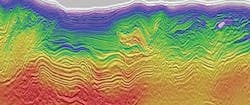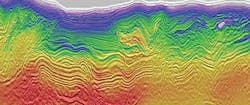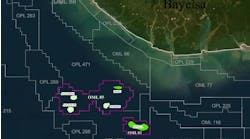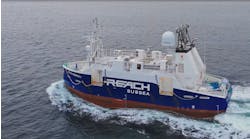Encontrado project sees large-scale subsalt velocity modeling in Perdido fold belt
Jo Firth
CGG
The recent energy reforms in Mexico prompted a flurry of activity in the Gulf of Mexico (GoM), with vast quantities of multi-client seismic data, mostly regional 2D grids, being acquired and processed. CGG has adopted a different strategy by reprocessing 3D data made available by the Mexican Comisión Nacional de Hidrocarburos (CNH) and applying advanced subsurface imaging techniques originally developed for use in the US Gulf of Mexico to the Mexican portion of the prolific Perdido fold belt. The intention is to turn this frontier area into a well-understood basin by using the latest technology to resolve large-scale complex geological challenges. This detailed regional pre-stack depth-migrated (PSDM) volume will be suitable for both basin-scale exploration and potential prospect evaluation and will enable structures offshore Mexico and the US to be correlated to define an accurate interpretation of the area.
To achieve this goal, CGG has merged nine existing surveys and is currently reprocessing them together as the Encontrado project. These data sets were acquired with a variety of different orientations and include both wide- and narrow-azimuth surveys. The combined data volume extends to over 38,000 sq km (15,000 sq mi), straddling the US/Mexico border, with about 35,000 sq km (13,513 sq mi) located in Mexican waters. The regional project has a vast scale, covering almost all the blocks released in the first deepwater license round, as well as those to be released in the second round and the Great White and Trion discoveries.
Several preprocessing steps were applied to mitigate acquisition differences between the various vintage data sets and provide a seamless image across the region. A key application was 3D deghosting, which delineated the top of salt with a strong positive impedance peak, resulting in a less ambiguous salt interpretation and a better velocity model.
The company’s experience of the geology and subsalt imaging in both the US and Mexican GoM enabled an initial Fast-Trax reverse time migrated (RTM) PSDM volume to be completed in May 2016, less than six months after initiating the project. The velocity model building for this initial data volume included several iterations of supra-salt tomography and incorporated generalized salt geometry definition. Velocity re-trending for shale and subsalt was used to create a velocity model that reflects the geological features of the region. The geology of this area is particularly complex, with salt walls extending from the US side through to Mexico. There is deeply rooted salt in the northwestern and southwestern parts of the survey, with salt diapirs in the central western area being mostly pinched due to compression caused by gravitational sliding. Despite the subsalt imaging challenges related to the salt geometry and illumination of the compressional steep dips, the Fast-Trax velocity model has enabled improved imaging of the Lower Tertiary and Mesozoic across the entire salt province, allowing better regional understanding of the Mexican side of the Perdido basin.
Efficient processing of a survey of this size through a sophisticated workflow pushes current technology to the limit. The complex geology of the GoM presents severe challenges for time imaging, therefore all work was carried out in depth migration flows. For the final velocity model, full waveform inversion (FWI) is being employed to refine the detail of the shallow velocity structures. Applying FWI to such a large dataset would not have been possible in the past, but CGG’s recent advances has made it accessible for large-scale production processing.
In addition, insertion of fast velocity for carbonate carapaces and slow velocity for shale mini-basins can provide correlation with stratigraphy. Slow-velocity anomalies can also be direct hydrocarbon indicators and help determine the potential prospectivity of shallow targets, as well as yielding information about possible geohazards. Incorporating these anomalies into a detailed velocity model mitigates the effects that they would cause on the deeper seismic image if left unresolved. Therefore, where there is a complex overburden, high-resolution velocity models improve the seismic imaging of the underlying strata as well as of the shallow data. Not only is the velocity model more conformable with the geology, but the entire seismic image is improved. Shallow graben faults are sharper and the clearer base of the rafted carbonates provides a better interpretation of the underlying salt.
Although new technologies like FWI and deghosting help determine a more precise top of salt, the correct geometry can still be ambiguous, especially where salt tectonics are affected by the regional compressional setting. Small changes in the shape of the salt can have a large influence on the subsalt image. Testing different scenarios can help increase confidence in decision-making and reduce risk in the assessment of subsalt targets. To further improve the deep image of this structurally complex basin, differentiating technologies such as RTM vector offset output and surface offset gathers will be used. These will enable better imaging in poorly illuminated areas and improve subsalt tomography.
The new Fast-Trax Encontrado data volume is already shedding new light on this complex but highly prospective area. Access to large, modern 3D surveys allows companies to reduce their risk and cut the time between award of license, drilling, and first production.




